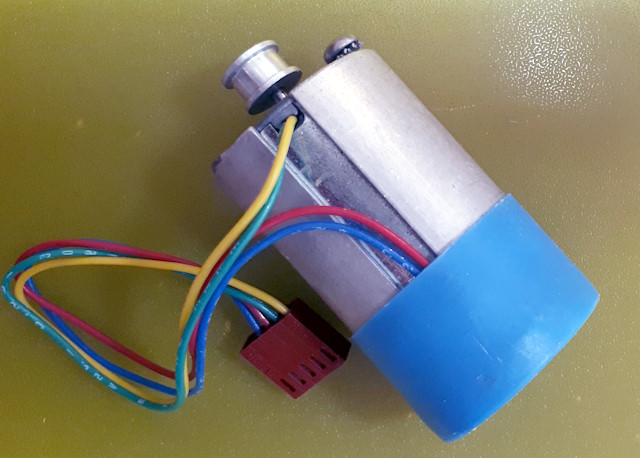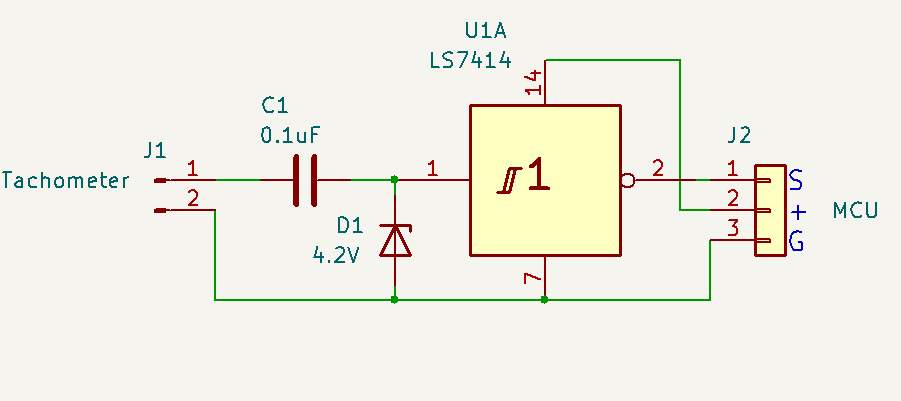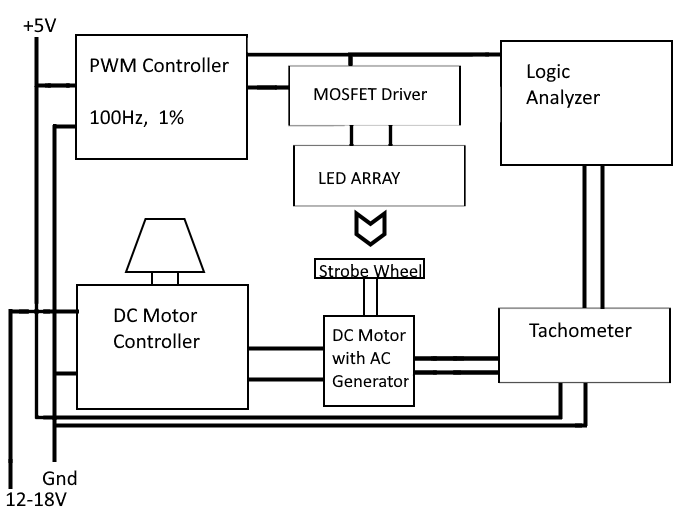AC Tachometer Converter Module
There is a variety of small DC motors that include an AC tachometer output. These motors are typically in
the 12-18V range, and spin at speeds of up to 2800RPM. They include
a tachometer as part of the motor. The AC tachometer produces a sine
wave (AC) output with a signal level that is proportional to the motor
speed, enabling the motor to be used in a closed-loop configuration. The
motors can be identified by a second pair of wires, often attached at the
opposite end to the drive wires, and sometimes associated with an distinct
end cap.
Because of the way that the output is created, the speed of rotation is
indicated by both amplitude and frequency. The amplitude is useful
for a simple analog display, but frequency is much more useful for
processing in a MCU, for instance in a closed-loop control configuration.
This simple circuit converts the sine wave output into a digital signal
that can be used with a MCU to measure the speed of the motor without the
need for ADC. This measurement is more accurate than using the signal
amplitude, although account must be taken of the number of of the number
of pulsess per revolution, which can vary for different motors.

Parts

DC Motor with AC Generator tachometer
Small prototyping board.
1x2-pin, 1x3-pin headers (or screw terminals)
4.2V Zener Diode
0.1uF Capacitor
74LS14N Hex Schmitt-Trigger inverter
14-pin socket (optional)
Hookup wire
Mounting base or feet.
Circuit
 The
tachometer output is an isolated AC signal that has a voltage that depends
on the type of motor and the motor speed, and can vary over a wide range.
In order to ensure that the current flow is controlled the signal is
isolated. One side is fed to a low-value capacitor, while the other is
tied to ground. A Zener diode is connected between the output of the
capacitor and ground. This does two things. Firstly it provides
half-wave rectification, so the sine wave output of the tachometer is
changed to a pulsed positive signal. Secondly it limits the positive
excursion of the signal to the 4.2V value of the Zener. This occurs
because the Zener conducts when the voltage across it exceeds that value.
Because of the capacitor isolation the current through the Zener is very
small - typically about 2mA, and less that 5mA even for large
motors. A 1/4W Zener is suitable in almost all cases.
The
tachometer output is an isolated AC signal that has a voltage that depends
on the type of motor and the motor speed, and can vary over a wide range.
In order to ensure that the current flow is controlled the signal is
isolated. One side is fed to a low-value capacitor, while the other is
tied to ground. A Zener diode is connected between the output of the
capacitor and ground. This does two things. Firstly it provides
half-wave rectification, so the sine wave output of the tachometer is
changed to a pulsed positive signal. Secondly it limits the positive
excursion of the signal to the 4.2V value of the Zener. This occurs
because the Zener conducts when the voltage across it exceeds that value.
Because of the capacitor isolation the current through the Zener is very
small - typically about 2mA, and less that 5mA even for large
motors. A 1/4W Zener is suitable in almost all cases.
Calibration

The output of the tachometer is a TTL digital signal derived from the
sine wave input of the AC generator. It runs at some multiple of the
motor RPM, depending on the number of poles in the AC generator.
The calibration that is required is to determine the number of poles in
the AC generator portion of the DC motor. This number determines how
many pulses per revolution are generated. This factor needs to be applied
to the raw pulse count to calculate the RPM.
If the motor specifications are known, or if the motor can be
disassembled and examined, then this step is not required.
This calibration does not include any adjustment for timing errors in the
measuring device (eg, the MCU). If that adjustment is required it
must be done separately.
The arrangement to find the number of poles requires the following
equipment:
- Strobe wheel for the motor (see below).
- Variable speed motor driver. Any module that varies the DC motor
speed using either PWM or voltage control is suitable.
- Frequency/Duty
Cycle (PWM) controller. This device creates the signal
to drive the LED used for the strobe. An adjustable duty cycle is
required so that the pulse can be kept very short.
- LED display for the strobe. In this example a 3x4-chip 5V panel
is used, but any reasonably bright display will work.
- Opto-isolated MOSFET driver. This provides the drive to the LED
module, ensuring that the PWM Controller output is not overloaded.
- Logic analyzer (or some other frequency counter).
The calibration procedure is to attach the strobe wheel to the motor,
then connect the variable speed driver. Also connect the driver PWM to the
logic analyzer.
Connect the tachometer to the motor and also to the logic analyzer, set
to display the pulse frequency speed in kHz.
Ensure that the grounds for all the devices are connected together.
The tachometer output is usually isolated so either connection can be used
as ground.
The jitter at the high level of the buffer output is apparently caused
by interference from the motor controller and is specific to this
hardware arrangement. It does not affect the result.
Procedure
 The
PWM controller is set to a duty cycle of 1% - the briefest possible pulse
per cycle. This ensures a very brief LED flash, so that the rotation of
the strobe wheel is captured. The output of the controller is
connected through the MOSFET driver to the LED array. The LED array
is shone onto the strobe wheel, and the frequency of the PWM controller is
adjusted until the strobe wheel image is stationery. The number of
poles is then calculated as the motor frequency divided by the strobe
frequency.
The
PWM controller is set to a duty cycle of 1% - the briefest possible pulse
per cycle. This ensures a very brief LED flash, so that the rotation of
the strobe wheel is captured. The output of the controller is
connected through the MOSFET driver to the LED array. The LED array
is shone onto the strobe wheel, and the frequency of the PWM controller is
adjusted until the strobe wheel image is stationery. The number of
poles is then calculated as the motor frequency divided by the strobe
frequency.
For instance, if the tachometer is recording a frequency of 800Hz and the
strobe frequency at which the strobe wheel is frozen is 100Hz then the AC
generator has 8 poles.
Note that a strobe wheel that is symmetrical will appear nearly
stationery at integer fractions and integer multiples of the motor
speed. However, some level of symmetry is useful in finding the
speed at which there is a match. The suggested layout of the wheel
is partly symmetrical, but enables the multiple to be identified.
The speed match is exact when there are no 'ghost' images of the red line.
The strobe pulse from the PWM controller is fed to the logic analyzer -
this signal may require a buffer, in which case a spare input/output on
the LS7414 is suitable. The Tachometer output is fed to another
channel on the logic analyzer, so the two frequencies can be compared.
Note that the measured frequency in this case is the frequency of the
cycle. This is because the timing calculation for the logic analyzer
is set to trigger on either the leading or trailing edge of the cycle, not
both. This means the frequency can be directly converted to
revolutions. If the analyzer triggers on both rising and falling
edges, or if the two traces are configured to trigger differently, this
must be allowed for in the frequency comparison. Both traces
triggering on one edge only is by far the simplest arrangement.
Strobe Wheel

The strobe wheel can be any suitable pattern, but the example shown here
works well. It is symmetrical except for one red spoke. The
pattern makes it easy to determine when the speed is synchronized to the
strobe LED, but the single red spoke shows clearly when the
synchronization is other than one-to-one. The second example shows half
flash speed - the red spoke is at the top on every second
revolution. The third example shows double flash speed - the red
spoke is revealed at each full revolution and also at each half
revolution. Similar patterns reveal other integer multiples
and fractions.
Logic Analyzer

The display from the logic analyzer shows the result when the strobe
light shows the wheel as stationery. Channel 0 is the tachometer, Channel
1 is the strobe trigger.
Channel 1 is firing at a rate of ~100Hz. The tachometer is pulsing
at a rate of ~800Hz. Because the strobe wheel is stationery at those
settings, there must be 1 strobe pulse for every rotation of the strobe
wheel.
So when the tachometer is connected to the MCU the frequency reading from
the tachometer must be divided by 8 to get the motor revolutions per
second. In practice, it is sometimes the case that the actual motor
rate is not required, and the tachometer rate can be used without
adjustment. But when the rate is required, the adjustment must be made.

 The
tachometer output is an isolated AC signal that has a voltage that depends
on the type of motor and the motor speed, and can vary over a wide range.
In order to ensure that the current flow is controlled the signal is
isolated. One side is fed to a low-value capacitor, while the other is
tied to ground. A Zener diode is connected between the output of the
capacitor and ground. This does two things. Firstly it provides
half-wave rectification, so the sine wave output of the tachometer is
changed to a pulsed positive signal. Secondly it limits the positive
excursion of the signal to the 4.2V value of the Zener. This occurs
because the Zener conducts when the voltage across it exceeds that value.
Because of the capacitor isolation the current through the Zener is very
small - typically about 2mA, and less that 5mA even for large
motors. A 1/4W Zener is suitable in almost all cases.
The
tachometer output is an isolated AC signal that has a voltage that depends
on the type of motor and the motor speed, and can vary over a wide range.
In order to ensure that the current flow is controlled the signal is
isolated. One side is fed to a low-value capacitor, while the other is
tied to ground. A Zener diode is connected between the output of the
capacitor and ground. This does two things. Firstly it provides
half-wave rectification, so the sine wave output of the tachometer is
changed to a pulsed positive signal. Secondly it limits the positive
excursion of the signal to the 4.2V value of the Zener. This occurs
because the Zener conducts when the voltage across it exceeds that value.
Because of the capacitor isolation the current through the Zener is very
small - typically about 2mA, and less that 5mA even for large
motors. A 1/4W Zener is suitable in almost all cases. 


 The
PWM controller is set to a duty cycle of 1% - the briefest possible pulse
per cycle. This ensures a very brief LED flash, so that the rotation of
the strobe wheel is captured. The output of the controller is
connected through the MOSFET driver to the LED array. The LED array
is shone onto the strobe wheel, and the frequency of the PWM controller is
adjusted until the strobe wheel image is stationery. The number of
poles is then calculated as the motor frequency divided by the strobe
frequency.
The
PWM controller is set to a duty cycle of 1% - the briefest possible pulse
per cycle. This ensures a very brief LED flash, so that the rotation of
the strobe wheel is captured. The output of the controller is
connected through the MOSFET driver to the LED array. The LED array
is shone onto the strobe wheel, and the frequency of the PWM controller is
adjusted until the strobe wheel image is stationery. The number of
poles is then calculated as the motor frequency divided by the strobe
frequency.

